Degree Days

Heating engineers who wanted a way to relate each day’s temperatures to the demand for fuel to heat buildings developed the concept of heating degree days.
To calculate the heating degree days for a particular day, find the day’s average temperature by adding the day’s high and low temperatures and dividing by two. If the number is above 65, there are no heating degree days that day. If the number is less than 65, subtract it from 65 to find the number of heating degree days.
For example, if the day’s high temperature is 60 and the low is 40, the average temperature is 50 degrees. 65 minus 50 is 15 heating degree days.
Cooling degree days are also based on the day’s average minus 65. They relate the day’s temperature to the energy demands of air conditioning. For example, if the day’s high is 90 and the day’s low is 70, the day’s average is 80. 80 minus 65 is 15 cooling degree days.
Heating and cooling degree days can be used to relate how much more or less you might spend on heating or air conditioning if you move from one part of the country to another. Of course you’d have to take into account how well insulated your new home will be in comparison to your old one and the different costs of electricity, gas or heating oil. You could also use records of past heating degree days to see if the money you’ve spent on insulation, or a newer furnace or air conditioner is paying off. To do this, you’d also need records of past energy use.
For more information, take a look at the NOAA website.
